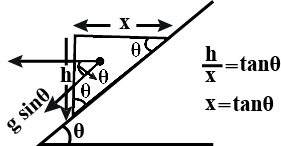Correct option is (1) \(\sqrt{\frac{2h }{g \sin^2 \theta }}\)
As no force other than gravity is acting on the particle P so it will not move in horizontal direction but due to movement of wedge it will reach the inclined plane.

Horizontal acceleration = gsinθcosθ
Distance to move = hcotθ
\(s = ut + \frac 12 at^2\)
\(h \cot\theta = \frac 12 g \sin \theta \cos\theta t^2\)
\(t = \sqrt{\frac{2h \cos \theta}{g \sin \theta \times \sin \theta .\cos\theta}}\)
\(t = \sqrt{\frac{2h }{g \sin^2 \theta }}\)